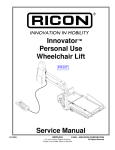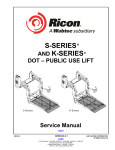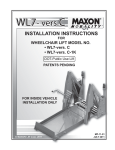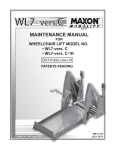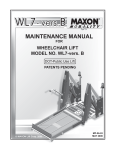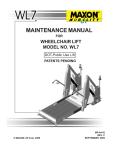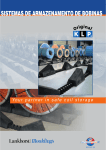Download Maxon WL7 Operating instructions
Transcript
OPERATING INSTRUCTIONS FOR WHEELCHAIR LIFT MODEL NO. • WL7-vers. C • WL7-vers. C-1K DOT-Public Use Lift ‘‘DOT-Public Use Lift’’ verifies that this platform lift meets the ‘‘public use lift’’ requirements of FMVSS No. 403. This lift may be installed on all vehicles appropriate for the size and weight of the lift, but must be installed on buses, school buses, and multipurpose passenger vehicles other than motor homes with a gross vehicle weight rating (GVWR) that exceeds 4,536 kg (10,000 lb). PATENTS PENDING © MAXON Lift Corp. 2009 1 MP-06-10 REV. A APRIL 2009 PATENTS PENDING PATENTS PENDING TABLE OF CONTENTS INTRODUCTION ............................................................................................... 4 SAFETY SUMMARY ......................................................................................... 4 DAILY PRE-OPERATION & OPERATION CHECKLIST .................................. 6 MAINTENANCE SCHEDULE ........................................................................... 8 LIFT COMPONENTS & TERMINOLOGY........................................................ 10 DECALS AND DECAL PLACEMENT .............................................................. 12 DECALS FOR WL7-vers. C............................................................................. 13 DECALS FOR WL7-vers. C-1K ...................................................................... 14 SERIAL PLATE & CONTROLLER OVERLAY ................................................. 15 ANTI-SLIP & SAFETY STRIPING .................................................................. 16 OPERATING INSTRUCTIONS ....................................................................... 20 ENTER VEHICLE ............................................................................................ 20 EXIT VEHICLE ................................................................................................ 23 STOW LIFT ..................................................................................................... 25 MANUAL PUMP OPERATION........................................................................ 26 LOADING & UNLOADING OCCUPANT.......................................................... 26 PATENTS PENDING INTRODUCTION This manual contains safety information and operating instructions for the Maxon Wheelchair and Standing Occupant Lift. Read and understand the WARNINGS, SAFETY CONSIDERATIONS, and operating instructions in this manual, before operating the Lift. SAFETY SUMMARY ! WARNING 1. This Wheelchair Lift is intended for commercial use only and should be operated by an attendant. Do not attempt to ride Lift without the assistance of an attendant. 2. Incorrect operation of this Lift can result in serious personal injury. Comply with the WARNINGS and Lift operating instructions in this manual. Do not allow untrained persons to operate the Lift. If you need to replace an Operator’s Manual, additional copies are available from: MAXON Lift Corp. 11921 Slauson Ave. Santa Fe Springs, CA 90670 (800) 227-4116 3. Do not exceed rated load capacity of Lift which is 800 lbs. (364 kg) for standard models and 1000 lbs. (453 kg) for the WL7-vers. C-1K. Refer to WARNING-CAPACITY decal “J” on the Lift. 4. Do not allow any part of your body, or the Lift occupant’s body, to be placed under, within, or around any portion of the moving Lift or its mechanisms, or in a position that would trap either of you between the platform and the ground (or vehicle) when Lift is operated. 5. Consider the safety and location of bystanders and location of nearby objects when operating the Lift. Stand to one side of platform while operating the Lift. Be certain that the area the Lift will move through during operation is clear of all obstacles. PATENTS PENDING 4 6. If possible, park the vehicle on level ground. Always set the vehicle emergency brake before operating the Lift. If the Lift is operated without setting the emergency brake, it may create a hazard for occupant and attendant. 7. Comply with all attached instruction decals and warning decals. 8. Above all, USE GOOD COMMON SENSE when operating this Lift. 9. Do not move vehicle when the wheelchair door is open. 10. MAXON recommends positioning the wheelchair so most of the weight is by the inboard rollstop (see illustration below). PLATFORM OUTBOARD ROLLSTOP INBOARD ROLLSTOP 11. An ambulatory (standing) occupant may face outboard or inboard. If possible, position ambulatory occupant on the Lift, facing the direction of travel (face vehicle when entering, face away when exiting) and holding on the handrails. 5 PATENTS PENDING DAILY PRE-OPERATION & OPERATION CHECKLIST NOTE: PRE-OPERATION and OPERATION CHECKS should be performed by the Lift operator. PRE-OPERATION CHECKS Park vehicle on level ground, shift vehicle transmission to PARK, and set vehicle emergency brake before doing the following checks. Visually check Lift for bent or broken parts, or for hydraulic fluid around base. Check for hydraulic fluid leaking from cylinders. Lift may be operated if cylinders are “weeping” a light film of hydraulic fluid. Check that all decals are in place, undamaged, and legible (see DECALS pages). Check that all anti-slip and safety striping are in place (see ANTISLIP & SAFETY STRIPING pages). If the Lift is dirty, clean it. Make sure the ON/OFF switch on the pump cover is turned ON. If the Lift controller display and hand control are illuminated, Lift has power to operate. NOTE: If any of the PRE-OPERATION CHECKS have incorrect indications, do not operate the Lift until repairs are performed by a qualified technician. PATENTS PENDING 6 OPERATION CHECKS Operate the Lift through one full cycle and do the following checks. Use Lift operating instructions in this manual to UNFOLD, LOWER, RAISE, and FOLD platform. Make sure the Lift responds properly to switches on the hand pendant. Listen for unusual noises while the Lift operates. Watch for uneven movement of the Lift arms, platform, and inboard and outboard rollstops. NOTE: If any of the OPERATION CHECKS have incorrect indications, discontinue operating Lift until repairs are performed by a qualified technician. 7 PATENTS PENDING MAINTENANCE SCHEDULE NOTE: The Lift controller (brain box) counts the number of cycles & lifts over the lifetime of the Lift. One CYCLE is counted each time the Lift is unfolded from the stowed position to floor level, lowered to the ground, raised to floor level, and then stowed. One LIFT is counted each time the Lift is lowered from floor level to the ground, and raised back to floor level. Read the LIFTS and CYCLES counts from the Lift brain box display window periodically so you know when to do the maintenance checks listed below. NOTE: Only a qualified technician should do the scheduled maintenance on this page and confirm compliance with Federal Motor Vehicle Safety Standard 403. For the compliance checks, refer to the COMPLETED LIFT INSTALLATION CHECKLIST in Installation Manual MP-06-09. EVERY 500 LIFTS Visually check the Lift for bent, broken, or worn out parts, and broken welds. Check the electrical wiring for worn insulation, and the terminals for corrosion and secure fit. Apply dielectric grease to connections if needed. Check for loose fasteners (nuts, bolts, screws & rivets). Also, check cotter pins, clevis pins, retaining ring pins & retaining rings for noticeable wear and damage. Check that all decals are in place, undamaged, and legible (see DECALS AND DECAL PLACEMENT pages). Check that all anti-slip and safety striping are in place and undamaged (see ANTI-SLIP & SAFETY STRIPING pages). Clean dust and debris from outboard switch & ground switch (magnetic switches on platform). (See ELECTRICAL COMPONENTS in the Maintenance Manual.) EVERY 2500 CYCLES Visually inspect the latch solenoids. If necessary, replace both latch solenoids P/N 266955-01. Apply multi-use teflon spray lubricant to the inboard rollstop spring lock & the plunger switch spring on the Lift. EVERY 5000 LIFTS Replace both platform light bulbs P/N 906475-01. EVERY 10000 LIFTS Check both hydraulic cylinders for leaks. If a film of hydraulic fluid is visible on cylinder seals, Lift can still be operated. However, if fluid is dripping from the cylinders, replace them. PATENTS PENDING 8 THIS PAGE INTENTIONALLY LEFT BLANK 9 PATENTS PENDING LIFT COMPONENTS & TERMINOLOGY INBOARD RIGHT 10 6 4 11 10 6 7 8 12 5 2 9 1 12 3 LEFT OUTBOARD LIFT COMPONENTS (SEE TABLE 11-1) FIG. 10-1 PATENTS PENDING 10 ITEM NAME DESCRIPTION 1. THRESHOLD PLATE Component that bridges the entry way, through the Lift, into the vehicle. Detects if that portion of Lift is occupied during “UP/ DOWN” operation between vehicle floor and the ground. 2. OUTBOARD ROLLSTOP Barrier to prevent the wheelchair from rolling off of the platform. Also provides entry/exit ramp for platform on the ground. 3. PLATFORM Contains the wheelchair and occupant during “UP/DOWN” operation between vehicle floor and the ground. 4. HANDRAILS (Left/Right) Provides a hand hold for the Lift occupant. 5. INBOARD ROLLSTOP Barrier to prevent the wheelchair from rolling off inboard side of platform. Also, provides bridge between platform and threshold. 6. HYDRAULIC CYLINDER (Left/Right) Telescoping steel tube and rod, pressurized by hydraulic fluid, that folds and unfolds the Lift and moves the Lift up and down. 7. HYDRAULIC POWER UNIT (COVER IS SHOWN) Contains motorized hydraulic pump, manually operated backup pump, fluid lines, and controls to operate the hydraulic cylinders. 8. LIFT CONTROLLER (BRAIN BOX) Electronic device that controls and monitors Lift operation and the interlock connection with the vehicle. 9. BASE Structure that secures Lift to the vehicle floor. 10. THRESHOLD WARNING BEACON Flashing red light indicates threshold is occupied by a person or object when the platform is below floor level. Also indicates outboard rollstop is open if platform is at floor level. 11. THRESHOLD WARNING ALARM Audible alarm sounds when threshold is occupied by a person or object when the platform is below floor level. Also indicates outboard rollstop is open if platform is at floor level. 12. PLATFORM LIGHTS Illuminates the platform when ready to load at floor level and during “UP/DOWN” operation between vehicle floor and the ground. TABLE 11-1 11 PATENTS PENDING DECALS AND DECAL PLACEMENT DECAL ”D” DECAL “O” DECAL “K” DECAL “A” DECAL “B” DECAL “F” DECAL “L” DECAL “M” DECAL“J” DECAL “I” DECAL“N” DECAL “C” DECAL “E” DECAL“N” DECAL “H” FIG. 12-1 All WARNING, CAUTION, and OPERATION decals provided with Wheelchair Lift must always be in place on the Lift and must always be legible. If decals are missing or illegible, get free replacement decals from: MAXON Lift Corp. - Customer Service 11921 Slauson Ave., Santa Fe Springs, CA 90670 Phone: (800) 227-4116 FAX: (888) 771-7713 E-mail: [email protected] PATENTS PENDING 12 DECALS FOR WL7-vers. C DECAL SET P/N 268302-01 FIG. 13-1 13 PATENTS PENDING DECALS AND DECAL PLACEMENT- Continued DECALS FOR WL7-vers. C-1K DECAL SET P/N 268302-03 FIG. 14-1 PATENTS PENDING 14 SERIAL PLATE & CONTROLLER OVERLAY CONTROLLER OVERLAY P/N 2667630-01 FIG. 15-1 SERIAL PLATE P/N 905246-8 FIG. 15-2 15 PATENTS PENDING ANTI-SLIP & SAFETY STRIPING (30” WIDE PLATFORM) YELLOW TAPE (BOTTOM-ROLLSTOP) P/N 905293-17 ANTI-SLIP TAPE (ROLLSTOP) P/N 096020-13 ANTI-SLIP TAPE P/N 096020-10 ANTI-SLIP TAPE P/N 096024-10 ANTI-SLIP TAPE P/N 096013-10 YELLOW TAPE (OUTBOARD) P/N 905293-11 YELLOW TAPE (OUTBOARD) P/N 905293-14 YELLOW TAPE (INBOARD) P/N 905293-16 ANTI-SLIP TAPE (ROLLSTOP) P/N 096020-13 YELLOW TAPE P/N 905293-11 YELLOW TAPE P/N 905293-14 FIG. 16-1 PATENTS PENDING 16 YELLOW TAPE (INBOARD & OUTBOARD) P/N 905293-13 (33” WIDE PLATFORM) YELLOW TAPE (BOTTOM-ROLLSTOP) P/N 905293-18 ANTI-SLIP TAPE (ROLLSTOP) P/N 096020-14 ANTI-SLIP TAPE P/N 096020-11 ANTI-SLIP TAPE P/N 096024-11 ANTI-SLIP TAPE P/N 096013-11 YELLOW TAPE (OUTBOARD) P/N 905293-11 YELLOW TAPE (OUTBOARD) P/N 905293-14 YELLOW TAPE (INBOARD) P/N 905293-16 ANTI-SLIP TAPE (ROLLSTOP) P/N 096020-14 YELLOW TAPE P/N 905293-11 YELLOW TAPE P/N 905293-14 YELLOW TAPE (INBOARD & OUTBOARD) P/N 905293-15 FIG. 17-1 17 PATENTS PENDING ANTI-SLIP & SAFETY STRIPING - Continued (34” WIDE PLATFORM) YELLOW TAPE (BOTTOM-ROLLSTOP) P/N 905293-18 ANTI-SLIP TAPE (ROLLSTOP) P/N 096020-15 ANTI-SLIP TAPE P/N 096020-12 ANTI-SLIP TAPE P/N 096024-12 ANTI-SLIP TAPE P/N 096013-11 YELLOW TAPE (OUTBOARD) P/N 905293-11 YELLOW TAPE (OUTBOARD) P/N 905293-14 YELLOW TAPE (INBOARD) P/N 905293-16 ANTI-SLIP TAPE (ROLLSTOP) P/N 096020-15 YELLOW TAPE P/N 905293-11 YELLOW TAPE P/N 905293-14 FIG. 18-1 PATENTS PENDING 18 YELLOW TAPE (INBOARD & OUTBOARD) P/N 905293-15 THIS PAGE INTENTIONALLY LEFT BLANK 19 PATENTS PENDING OPERATING INSTRUCTIONS ENTER VEHICLE NOTE: If equipped, seat belt must be fastened for Lift to operate. 1. Fully open and secure Wheelchair Lift access door(s) on the vehicle. ON OFF PUMP COVER POWER SWITCH (LH PUMP SHOWN) FIG. 20-1 2. Apply power to the Lift by turning on the switch on the pump cover (FIG. 20-1). The POWER light on the hand pendant illuminates (FIG. 20-2). DOWN UNFOLD POWER (ON) LIGHT HAND PENDANT FIG. 20-2 3. Push the UNFOLD switch on hand pendant (FIG. 20-2) to unfold platform to horizontal position (FIG. 20-3) until platform lights come on. FLOOR LEVEL PLATFORM LIGHT UNFOLD PLATFORM FIG. 20-3 PATENTS PENDING 20 4. Push the DOWN switch on hand pendant (FIG. 18-2) to lower platform to ground level (FIG. 21-1). LOWER PLATFORM TO GROUND FIG. 21-1 5. If equipped, unfasten seat belt (FIG. 21-2). Place on hanger (FIG. 21-3). UNFASTENING SEAT BELT (RH HANDRAIL SHOWN) FIG. 21-2 SEAT BELT ON HANGER (LH HANDRAIL SHOWN) FIG. 21-3 6. Position wheelchair or ambulatory occupant on the center of platform (FIG. 21-4). Set wheelchair brakes or switch off powered wheelchair. POSITIONING OCCUPANT ON PLATFORM AT GROUND LEVEL FIG. 21-4 21 PATENTS PENDING OPERATING INSTRUCTIONS - Continued 7. If equipped, fasten seat belt (FIG. 22-1). FASTENING SEAT BELT (RH HANDRAIL SHOWN) FIG. 22-1 8. Push the UP switch on hand pendant (FIG. 22-2) to raise platform to vehicle floor level (FIG. 22-3). UP DOWN UNFOLD HAND PENDANT FIG. 22-2 RAISING LIFT UP TO VEHICLE FLOOR LEVEL FIG. 22-3 9. Release wheelchair brakes or switch on powered wheelchair. Move wheelchair or ambulatory occupant inside the vehicle. PATENTS PENDING 22 EXIT VEHICLE 1. Fully open and secure Wheelchair Lift access door(s) on the vehicle. FLOOR LEVEL PLATFORM LIGHT 2. Push the UNFOLD switch on hand pendant (FIG. 22-2) to unfold platform to horizontal position (FIG. 23-1) until platform lights come on. UNFOLD PLATFORM FIG. 23-1 3. If equipped, make sure seat belt is fastened (FIG. 23-2). FASTENING SEAT BELT (RH HANDRAIL SHOWN) FIG. 23-2 4. Position wheelchair or ambulatory occupant on the center of platform (FIG. 23-3). Set wheelchair brakes or switch off powered wheelchair. POSITIONING OCCUPANT ON PLATFORM AT FLOOR LEVEL FIG. 23-3 5. Push the DOWN switch on hand pendant (FIG. 22-2) to lower platform to ground level (FIG. 23-4). LOWERING PLATFORM TO GROUND FIG. 23-4 23 PATENTS PENDING OPERATING INSTRUCTIONS - Continued 6. If equipped, unfasten seat belt (FIG. 24-1). Place on hanger (FIG. 24-2). UNFASTENING SEAT BELT (RH HANDRAIL SHOWN) FIG. 24-1 SEAT BELT ON HANGER (LH HANDRAIL SHOWN) FIG. 24-2 7. Release wheelchair brakes or switch on powered wheelchair. Move wheelchair or ambulatory occupant into the passenger unloading zone. PATENTS PENDING 24 STOW LIFT 1. If equipped, fasten seat belt (FIG. 25-1). FASTENING SEAT BELT (RH HANDRAIL SHOWN) FIG. 25-1 UP 2. Push the UP switch on hand pendant (FIG. 25-2) to raise platform to vehicle floor level (FIG. 25-3). FOLD HAND PENDANT FIG. 25-2 RAISING LIFT TO VEHICLE FLOOR LEVEL FIG. 25-3 3. Push the FOLD switch on hand pendant (FIG. 25-2) to fold platform (FIG. 25-4). Fold operation will stop automatically when completed. FOLDING PLATFORM UP INTO VEHICLE FIG. 25-4 25 PATENTS PENDING MANUAL PUMP OPERATION LOADING & UNLOADING OCCUPANT LATCH 1. Reposition latches to manually unfold the Lift as follows. Raise latch off anchor pin (FIG. 261A) on LH side of Lift. Position the standoff to REPOSITIONED hold latch in place above LATCH & STANDOFF the anchor pin (FIG. FIG. 26-1B 26-1B). Repeat for latch on RH side of Lift. STANDOFF ANCHOR PIN LIFT - BACK VIEW FIG. 26-1A 2. Remove the manual backup handle from clips on the pump cover (FIG. 26-2). PUMP COVER HANDLE MANUAL BACKUP HANDLE (LH PUMP SHOWN) FIG. 26-2 PATENTS PENDING 26 3. Unfold the platform as follows. Open release valve on manual pump by turning manual backup handle counter-clockwise (FIG. 27-1). Start with 1/4 turn and slowly increase to 1/2 turn counterclockwise. 1/4 - 1/2 TURN OPEN RELEASE VALVE FIG. 27-1 4. Observe the platform unfolding to horizontal position at vehicle floor level (FIG. 27-2). UNFOLD PLATFORM FIG. 27-2 5. When the platform reaches floor level, close release valve on manual pump by turning manual backup handle clockwise until tight (FIG. 27-3). TIGHTEN CLOSE RELEASE VALVE FIG. 27-3 27 PATENTS PENDING MANUAL PUMP OPERATION - Continued OUTBOARD ROLLSTOP 6. Ensure outboard rollstop is raised all the way (FIG. 28-1). OUTBOARD ROLLSTOP RAISED UP FIG. 28-1 7. If equipped, make sure seat belt is fastened (FIG. 28-2). FASTENING SEAT BELT (RH HANDRAIL SHOWN) FIG. 28-2 NOTE: If there are no occupants to unload from vehicle, skip step 8. 8. Position wheelchair or ambulatory occupant on the center of platform (FIG. 28-3). Set wheelchair brakes or switch off powered wheelchair. PATENTS PENDING POSITIONING OCCUPANT ON PLATFORM FIG. 28-3 28 9. Lower the platform as follows. Re-enter the vehicle to access manual pump. Open release valve on manual pump by turning manual backup handle counter-clockwise (FIG. 291). Lower the Lift slowly below floor level and check if inboard rollstop is raised and locked in the up position (FIG. 29-2). OPEN RELEASE VALVE FIG. 29-1 INBOARD ROLLSTOP PLATFORM LOWERED, INBOARD ROLLSTOP UP FIG. 29-2 10. Watch platform (FIG. 293) as it lowers occupant to the ground. LOWERING PLATFORM TO GROUND FIG. 29-3 11. When platform rests on the ground, close release valve on manual pump by turning manual backup handle clockwise until tight (FIG. 29-4). TIGHTEN CLOSE RELEASE VALVE FIG. 29-4 29 PATENTS PENDING MANUAL PUMP OPERATION - Continued 12. If equipped, unfasten seat belt (FIG. 30-1). Place on hanger (FIG. 30-2). UNFASTENING SEAT BELT (RH HANDRAIL SHOWN) FIG. 30-1 SEAT BELT ON HANGER (LH HANDRAIL SHOWN) FIG. 30-2 13. Ensure outboard rollstop on the platform is opened to the horizontal position (FIG. 30-3). OUTBOARD ROLLSTOP NOTE: If there are no occupants to unload, skip steps 14 & 15. OUTBOARD ROLLSTOP IN HORIZONTAL POSITION FIG. 30-3 14. Release wheelchair brakes or switch on powered wheelchair. Move wheelchair or ambulatory occupant into the unloading zone. 15. Position wheelchair or ambulatory occupant on the center of platform (FIG. 30-4). Set wheelchair brakes or switch off powered wheelchair. POSITIONING OCCUPANT ON PLATFORM FIG. 30-4 16. If equipped, fasten seat belt (FIG. 30-5). PATENTS PENDING 30 FASTENING SEAT BELT (RH HANDRAIL SHOWN) FIG. 30-5 CAUTION Prevent the manual backup handle from getting damaged. Before you start pumping with the handle, line up notches on tip of handle as shown in FIG. 29-1. Then fully engage handle with manual pump as shown in FIG. 29-2. NOTCHES LINED UP VERTICAL HANDLE - NOTCHES LINED UP CORRECTLY FIG. 31-1 HANDLE FULLY ENGAGED FIG. 31-2 17. Raise the platform as follows. Insert manual backup handle in manual pump actuator. Pump the handle up and down (FIG. 31-3) until platform is raised up even with the vehicle floor (FIG. 31-4) and inboard rollstop lowers to rest on threshold plate. PUMPING MANUAL BACKUP HANDLE FIG. 31-3 RAISING LIFT TO VEHICLE FLOOR FIG. 31-4 31 PATENTS PENDING NOTE: If there are no occupants to load on platform, skip step 18. 18. Release wheelchair brakes or switch on powered wheelchair. Move wheelchair or ambulatory occupant inside the vehicle. PUMPING MANUAL BACKUP HANDLE FIG. 32-1 19. Stow the Lift as follows. Pump the manual backup handle up and down (FIG. 32-1) until platform folds up tightly inside the vehicle (FIG. 32-2). FOLDING PLATFORM UP INTO VEHICLE FIG. 32-2 20. Store manual backup cover on pump cover (FIG. 32-3) using the clips provided. PUMP COVER HANDLE MANUAL BACKUP HANDLE (LH PUMP SHOWN) FIG. 32-3 PATENTS PENDING 32


































